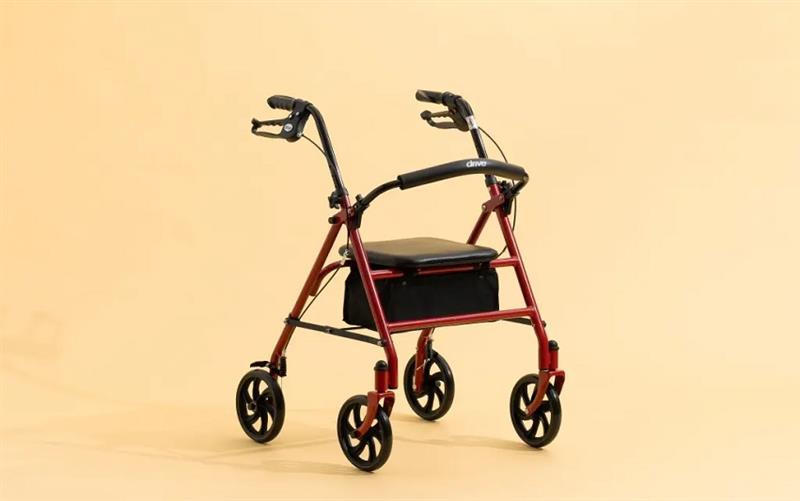
Rollators are more than just mobility aids; they are instruments that give elderly people their freedom, self-assurance, and happiness back. Rollators enable elders to remain active, preserve their independence, and take part in the activities they love by improving mobility and fostering a sense of security.
Maintaining our mobility as we get older is essential to retaining our freedom and standard of living. Combining stability, comfort, and independence, rollators offer a vital answer to mobility issues for a large number of elders. This blog examines the ways in which rollators enable seniors to maintain their independence, safety, and level of activity in their daily lives.
A rollator is a mobility assistance on wheels that has a seat, handlebars, a strong frame, and frequently a storage basket. Rollators are easier to manage because they have three or four wheels, unlike ordinary walkers. They are made to help people walk more confidently and naturally while also offering support and balance.
Benefits of Rollators for Seniors
1. Increased Mobility
Rollators help seniors move around freely, both indoors and outdoors.
- Smooth Navigation: The wheels make it easy to navigate uneven surfaces, tight corners, and inclines.
- Longer Walks: Seniors can take breaks using the built-in seat, enabling them to travel further distances without fatigue.
2. Enhanced Independence
Rollators enable seniors to perform daily activities with minimal assistance.
- Running Errands: With a rollator’s storage basket or bag, seniors can carry groceries, personal items, or even medical supplies.
- Social Engagement: Attending social events or visiting loved ones becomes more manageable, reducing isolation and enhancing mental well-being.
3. Improved Safety
Falls are a significant concern for seniors, but rollators provide much-needed stability.
- Sturdy Support: The handlebars and locking brakes offer reliable balance, especially for those with limited strength or coordination.
- Reduced Fall Risk: The steady design minimizes the chances of tripping or losing balance during movement.
4. Comfort and Convenience
Rollators are designed with features that cater to seniors’ unique needs.
- Built-In Seats: When tired, users can rest on the comfortable seat without searching for a bench.
- Adjustable Height: Most rollators allow handle and seat height adjustments to suit individual needs, promoting better posture and comfort.
5. Encourages Active Lifestyles
By making movement easier, rollators motivate seniors to stay active.
- Daily Walks: With the added stability, seniors are more likely to enjoy walks, whether for exercise or leisure.
- Participation in Activities: From gardening to light shopping, rollators support seniors in staying involved in their favorite hobbies
6. Promotes Better Posture
Rollators encourage users to walk upright rather than hunching over, which is common with traditional walkers.
- Adjustable Handles: Ensure proper alignment, reducing strain on the back and shoulders.
- Ergonomic Design: Provides a natural walking posture, minimizing discomfort during extended use.
7. Reduces Strain on Joints
Rollators offer smooth mobility, reducing the physical effort required for walking.
- Weight Distribution: The frame supports body weight, taking pressure off knees, hips, and ankles.
- Eases Pain: Ideal for seniors with arthritis or joint pain, as it makes movement less taxing.
8. Boosts Confidence in Crowded Spaces
Navigating busy areas can be intimidating for seniors with mobility challenges. Rollators provide extra support and reassurance.
- Stability in Movement: Ensures balance even in uneven or crowded environments.
- Compact Maneuverability: Allows for smooth navigation in narrow aisles, public transport, or busy sidewalks.
9. Facilitates Rehabilitation and Recovery
Rollators are excellent aids for seniors recovering from surgeries, injuries, or illnesses.
- Supports Gradual Mobility: Helps users rebuild strength and stamina post-surgery or during physical therapy.
- Encourages Regular Activity: Provides a safe way to maintain movement during recovery, speeding up rehabilitation.
10. Versatile Usage Across Environments
Rollators adapt to various settings, making them highly versatile mobility aids.
- Indoor and Outdoor Use: Whether at home, the park, or a shopping mall, rollators perform well on different surfaces.
- All-Weather Mobility: Rollators with durable wheels and frames can handle light rain or uneven outdoor terrain.
Choosing the Right Rollator:
1. Determine the Rollator Type
Rollators come in different configurations to meet varying mobility needs.
- Three-Wheel Rollators: Lightweight and compact, ideal for maneuvering through tight spaces but without a built-in seat.
- Four-Wheel Rollators: Offer greater stability, often with a seat and storage for added convenience.
- Heavy-Duty Rollators: Designed for bariatric users, these models have a higher weight capacity and wider seats.
- Compact or Travel Rollators: Foldable and lightweight, perfect for seniors who frequently travel or need easy storage.
2. Consider the Wheel Size
Wheel size impacts how well the rollator performs on different surfaces.
- Small Wheels (6 inches or less): Best for indoor use on smooth floors.
- Large Wheels (8 inches or more): Provide better stability and performance on outdoor terrains like gravel, grass, or uneven surfaces.
3. Assess Weight Capacity
Each rollator has a specific weight capacity to ensure safety and durability.
- Standard Rollators: Typically support up to 250–300 pounds.
- Bariatric Rollators: Designed for heavier users, these can accommodate weights of 350–500 pounds or more.
Always check the weight capacity before purchase to ensure it matches the user’s needs.
4. Look for Adjustability
A properly fitted rollator enhances comfort and reduces strain.
- Handle Height: Adjustable handles ensure that users maintain a proper upright posture. Measure from the user’s wrists to the ground while standing for accurate height adjustment.
- Seat Height: Choose a rollator with a seat height that matches the user’s leg length to sit comfortably without their feet dangling.
5. Evaluate the Braking System
Safety is paramount when using a rollator, so the braking system is critical.
- Loop Brakes: Easy-to-operate brakes commonly found on most rollators, activated by squeezing handgrips.
- Push-Down Brakes: Ideal for users with limited hand strength, activated by pressing down on the handles.
Test the brakes for smooth operation and responsiveness.